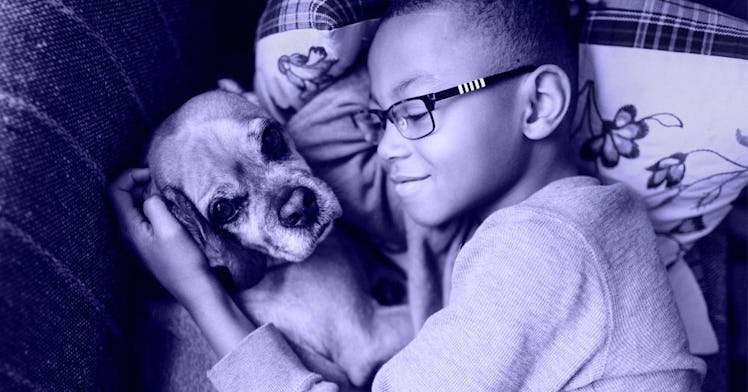7 Harsh Truths About Kids and Dogs Parents Should Consider
Kids love dogs and some dogs love kids, but the harsh truth is that children and canines may not always be compatible when a parent finally decides to make the pet plunge.

Dogs are vessels of unconditional love. And children flourish when someone loves them unconditionally. This makes for compatibility and makes it easy to believe that children and dogs were meant to be together. And that is mostly true. But in their zeal to give children a tireless furry companion, parents often forget some important facts. Dogs require more than kibble and a cozy place to sleep and children need more than a cursory explanation about which end of the dog has the teeth.
The harsh truth is that creating a beautiful and memorable relationship between child and dog requires both time and effort. Then, after the effort is put in, the outcomes may not always be what the parent hoped for or expected. From expenses to the fact that dogs aren’t a tool to teach responsibility, these are the harsh truths parents should consider before parents come home with a pal from the pound.
Harsh Truth #1: Babies and Puppies Don’t Mix
There are few pictures that can receive as much social media love as a baby frolicking with a puppy. The cuteness is concentrated and none shall be spared. But sadly, the kid and canine cuteness may actually be a vision of danger.
The problem is that puppies have a tendency to bite and babies have a tendency to pull hair, tails, and anything that happens to be dangling in their general vicinity. Will the new family puppy definitely injure your child? No. But when dogs do injure or kill people, the chances are good that the victim will be a child.
To improve the odds parents should hold off on getting puppy and baby together. It’s better to wait until the dog is at least one year old and the kid is at least age 5.
Harsh Truth #2: The Dog’s Death Will Devastate Your Kid
For many children, their first experience of mourning comes when their beloved pet dies. Granted, a well taken care of canine will have a long, fruitful life, but death comes for us all. And even the longest dog lives come to an end all too quickly.
Importantly, mourning is mourning. A child’s grief over a dog is no less acute than the grief they might feel at the passing of a grandparent. Parents need to pay attention as a dog’s life ends. Conversations about things ending should happen early and be child appropriate. If done well, a child coming to understand death through the loss of a pet can be profound and transformational, but that won’t happen if Fido goes to chase rabbits on some mythical farm.
Harsh Truth #3: Owning a Dog Does Not Teach Kids Responsibility
While owning a dog can teach children about death, it’s less likely that the care and feeding of an animal will teach a child responsibility. That can be particularly frustrating when a parent has adopted a dog for that very purpose.
At some point, the novelty will wear off and feeding, walking and picking up poop will become chores. Those chores will lead to inevitable complaints and whining, resulting in bad feelings all around, with the dog at the center of the resentment. That’s simply not fair.
It’s better to bring a dog into the family understanding that they will be the family’s companion and shared responsibility. Parents who want to teach kids a good work ethic should simply give those kids standard household chores.
Harsh Truth #4: Dogs Are More Expensive Than Parents Think
An adopted dog arrives in the home with hidden costs parents may not have anticipated. Yes, there are the standard expenses for kibble and vet visits, but parents should also add in the cost of training, replacement of chewed-up household items, regular floor, and upholstery maintenance and so very many chewy, squeaky and furry toys.
Harsh Truth #5: Introducing a Kid to a Dog Takes Time
Some parents might believe that when a kid meets a dog, the natural order is for the pair to become fast friends immediately. But there is a wild range of factors that affect the kid/dog dynamic. That means introducing kids to dogs should be a thoughtful and deliberate process.
Among the biggest concerns, parents should consider how much experience their child has had with dogs in the first place. Not to mention the temperament of the dog. A timid kid with an excitable and goofy dog could lead to nipped hands and faces and, ultimately, tears.
Harsh Truth #6: Dogs Need to Be Trained
One of the most marvelous things about dogs is that looking for guidance from humans has the power to make them happier and more contented. An untrained dog is relying on its own instincts rather than looking to owners for guidance. Those instincts can sometimes lead them literally astray.
With a child in the picture, an untrained dog is a liability. Parents should be able to tell a dog to sit, stay or “leave it” and know that they will comply, particularly if the dog is becoming over-excited with a child.
Harsh Truth #7: A Child Will Like Their Dog More Than Their Sibling
Research shows that when it comes to family relationships, siblings drool and dogs rule. A recent study revealed that when it comes to relationships in the home, kids reported that they felt more satisfaction and less conflict with dogs than siblings.
Frankly, that makes sense.